Caring for Japanese Aralia Indoors
Botanical Name: Fatsia japonica
Japanese aralia makes an attractive, tall houseplant with glossy, lobed leaves. This handsome evergreen shrub will live for years with good care.
Here, you'll find out what kind of sunlight it wants year-round, how much to water (it's a heavy drinker!) and why you'll want to pinch and prune your plant.
 Photo istockphoto.com
Photo istockphoto.comGet to Know Japanese Aralia
Japanese aralia is a member of the Araliaceae family commonly grown outdoors in frost-free climates. Indoors, it can be kept small by regular pruning. Cut it back drastically in spring -- by half when necessary -- and pinch off growing tips to encourage branching.
Fatsia japonica is a fast-growing, evergreen shrub. Long, upright leaf stems hold glossy, lobed leaves with pointed tips. Each leaf has between 7-9 lobes and can reach up to 12 in (30 cm) across.
I know of a couple cultivars you may want to look for. F. japonica 'Moseri' is more compact than the species, giving it a fuller appearance. F. japonica 'Variegata' sports leaves edged with white.
How big does Fatsia japonica get? You can expect it to reach a height of 6 ft (1.8 m) when grown in a pot indoors. Older plants may need staked to stand upright.
Will it bloom? Perhaps. Clusters of creamy-white flowers may appear on mature plants in fall, followed by shiny, green fruit that turn black as they ripen. However, it rarely flowers indoors.
You can move Japanese aralia outdoors in summer if you want. Just be sure to put it in a shaded spot outside because direct sun can burn its leaves.
Give it a winter rest. This plant needs a rest in winter. It won't go dormant, but its growth will slow down. Move it to a cool spot where the temperature doesn't dip below 45°F/7°C , water less frequently and stop fertilizing for the winter.
Japanese Aralia Problems, Solutions and How-tos
Keep it clean. Wipe the leaves frequently with a damp cloth to keep them dust-free. DO NOT use leaf shine products, which can damage them. This handsome plant doesn't need it anyway; its leaves are naturally shiny.
Leaves dropping? You can expect the lower, older leaves to fall off. However, if your Japanese aralia looks too leggy, don't be afraid to prune it back hard -- by half, if necessary. Spring is the best time to prune it, when the plant is beginning its most vigorous time of growth.
Yellow leaves are often caused by soggy soil. Another cause of yellowing leaves may be lack of nutrients. (See "Fertilizer" below.)
Repot in spring when the plant becomes root-bound. Use a heavy container to prevent toppling, because plants can get top-heavy. Larger plants can be top-dressed instead by replacing the top 2-3 in (5-7.5 cm) with fresh potting mix. Use a pot with drainage holes to prevent soggy potting mix, which can cause root rot.
Something bugging your houseplant? Check leaves regularly for spider mites, aphids and mealy bugs. Isolate an infested plant and treat it immediately with insecticidal soap.
Watch for fungus. The cool, moist and shady environment F. japonica prefers may attract botrytis. It's a fungus that looks like grayish-brown patches. Left to grow, botrytis will cause the leaves to turn soft, curl up and possibly fall off. Cut off any affected leaves and spray the plant with a fungicide. It's a good idea to keep Japanese aralia where it will get good air circulation.
 Photo: istockphoto.com
Photo: istockphoto.comJapanese Aralia Care Tips
Light: Bright light; but no direct summer sun which can scorch its leaves.
Water: Keep soil evenly moist spring through fall, slightly drier in winter when growth slows down. Use a pot with drainage holes; water thoroughly to wet all the roots, then empty the drainage tray.
Humidity: Aim to maintain at least 45% relative humidity. Indoor air can become extremely dry in winter, without our noticing it. It's a good idea to use a humidity gauge near your houseplant, rather than guess. If the humidity drops, the most efficient way to raise it is to use a cool-mist room humidifier near your plant.
Temperature: 50-55°F/10-13°C nights; 60-65°F/16-18°C days
Soil: Good-quality, all-purpose potting mix
Fertilizer: Feed every 2 weeks spring and summer with a balanced water-soluble fertilizer. Yellow leaves on Japanese aralia indicate lack of nitrogen.
Propagation: Take 4-inch (10cm) stem tip cuttings with leaves attached in spring and place in moist perlite or sterile potting mix. Use a seedling heat mat to keep cuttings warm, and enclose cuttings in a plastic bag to maintain high humidity.


